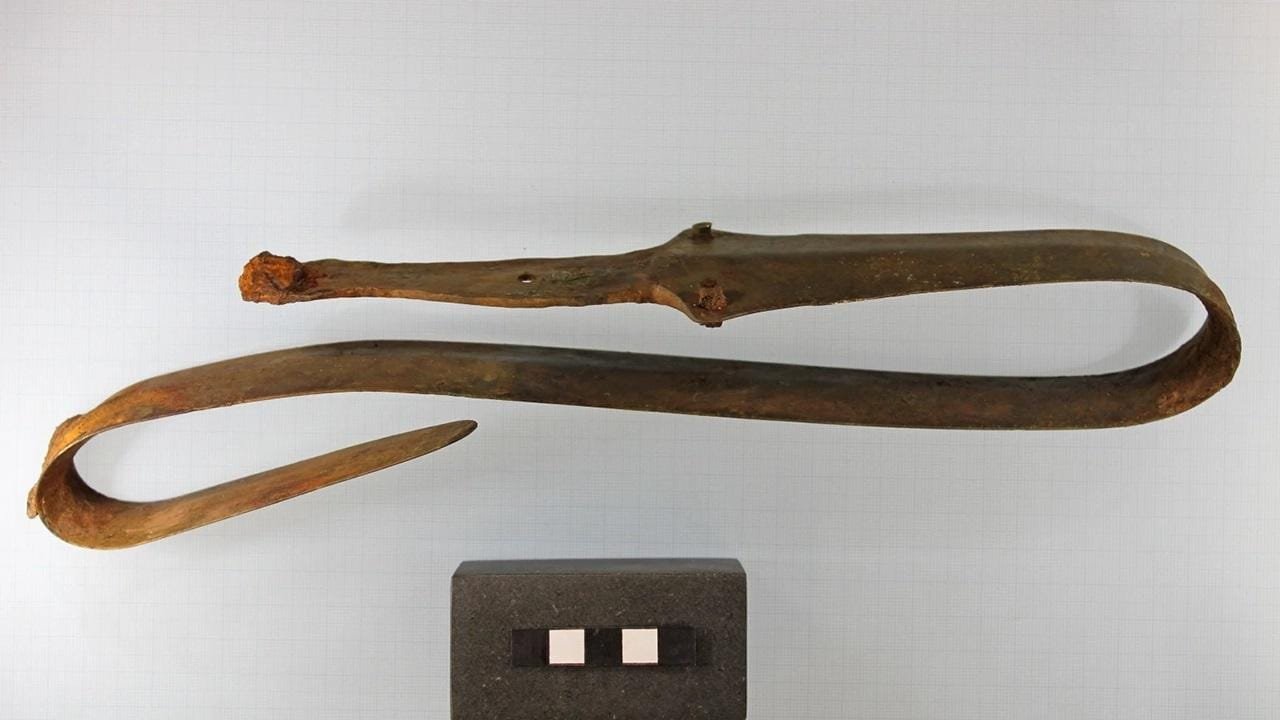A stunning discovery of Late Bronze Age artifacts, including a ritualistically bent sword, has been made in a bog near Veksø, west of Copenhagen, Denmark. The find was made by amateur metal detectorist Claus Falsby.
 Sword from the Late Bronze Age. The sword was ritually bent before being laid down as an offering. Credit: Palle Østergaard Sørensen, ROMU
Sword from the Late Bronze Age. The sword was ritually bent before being laid down as an offering. Credit: Palle Østergaard Sørensen, ROMU
This discovery, referred to as the “Egedal Find,” was made in the Værebro Ådal conservation area, a protected region of bogs and freshwater systems. Among the uncovered items were a bronze sword with iron rivets, two small axes, three ankle rings, a fragment of a large pin, and a mysterious, unidentified object. Days after the initial excavation, Falsby also located a finely crafted bronze neck ring about 70 meters from the original site.
Emil Winther Struve, an archaeologist with ROMU, the museum organization overseeing cultural heritage in the Egedal Municipality, described the find as exceedingly rare. “We have numerous hoards from the Early and Middle Bronze Age where bronze artifacts are discovered in bogs, but finds from the Late Bronze Age are far fewer,” he explained.
The bent sword, Struve noted, is especially significant. It combines bronze and iron, materials representing the evolving technological landscape of the period. The sword’s iron rivets are among Denmark’s earliest known uses of iron, suggesting it was crafted around 500 BCE. The design indicates it was not locally made but imported from regions north of the Alps, likely influenced by the Hallstatt culture, a warrior society that dominated the late Bronze Age in Europe.
“The Hallstatt culture spread rapidly, characterized by a warrior ethos with an emphasis on conquest and conflict,” Struve said. “Their swords were sturdier, heavier, and more suitable for slashing rather than stabbing, reflecting a shift in combat techniques.”
The discovery site was a bog, a common location for ritual deposits during the Bronze Age. The artifacts had been deliberately damaged, with the sword bent to render it unusable as a weapon, a practice believed to imbue the offerings with greater symbolic value.
Struve explained that although votive traditions were declining by the Late Bronze Age, they had not entirely disappeared. The Egedal Find demonstrates that the local elite near the Værebro River Valley continued these costly rituals, perhaps as a way to maintain ties to their cultural heritage during a period of transformation.
The bronze neck ring discovered days later is also notable, being only the second of its kind found in Denmark. Researchers suggest it may have originated from trade networks connected to the Polish Baltic coast, underscoring the region’s role in broader European exchange systems during the era.
The Egedal Find joins a legacy of significant discoveries from the region, including the Smørumovre Hoard of 1851, featuring 163 early Bronze Age objects, and the Veksø Helmets from 1942, renowned examples of mid-Bronze Age craftsmanship.
The artifacts have been submitted to the Danish National Museum for preservation and further study. Struve is particularly eager to analyze the materials in the sword to pinpoint its origin. “We don’t have many swords of this type in Denmark. The preservation of the iron rivets in the handle is remarkable,” he said. “The sword will undoubtedly look incredible once the National Museum completes its conservation.”
Source: ROMU





